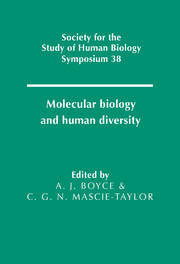Book contents
- Frontmatter
- Contents
- List of contributors
- Preface
- 1 Mitochondrial DNA in ancient and modern humans
- 2 Digital DNA typing of human paternal lineages
- 3 Minisatellites as tools for population genetic analysis
- 4 DNA fingerprinting: development of a technology and its application to the study of human populations
- 5 Kinship, inbreeding, and matching probabilities
- 6 Using the coalescent to interpret gene trees
- 7 Some attempts at measuring natural selection by malaria
- 8 AIDA: Geographical patterns of DNA diversity investigated by autocorrelation statistics
- 9 Mitochondrial DNA sequences in Europe: an insight into population history
- 10 Palaeolithic and neolithic contributions to the European mitochondrial gene pool
- 11 The molecular diversity of the Niokholo Mandenkalu from Eastern Senegal: an insight into West Africa genetic history
- 12 The peopling of Madagascar
- 13 Molecular perspectives on the colonisation of the Pacific
- 14 Population ancestry on Tristan da Cunha–the evidence of the individual
- 15 Linguistic divergence and genetic evolution: a molecular perspective from the New World
- 16 Allelic sequence diversity at the human β-globin locus
- 17 A nuclear perspective on human evolution
- 18 Contrasting gene trees and population trees of the evolution of modern humans
- 19 Methods and models for understanding human diversity
- Index
12 - The peopling of Madagascar
Published online by Cambridge University Press: 19 September 2009
- Frontmatter
- Contents
- List of contributors
- Preface
- 1 Mitochondrial DNA in ancient and modern humans
- 2 Digital DNA typing of human paternal lineages
- 3 Minisatellites as tools for population genetic analysis
- 4 DNA fingerprinting: development of a technology and its application to the study of human populations
- 5 Kinship, inbreeding, and matching probabilities
- 6 Using the coalescent to interpret gene trees
- 7 Some attempts at measuring natural selection by malaria
- 8 AIDA: Geographical patterns of DNA diversity investigated by autocorrelation statistics
- 9 Mitochondrial DNA sequences in Europe: an insight into population history
- 10 Palaeolithic and neolithic contributions to the European mitochondrial gene pool
- 11 The molecular diversity of the Niokholo Mandenkalu from Eastern Senegal: an insight into West Africa genetic history
- 12 The peopling of Madagascar
- 13 Molecular perspectives on the colonisation of the Pacific
- 14 Population ancestry on Tristan da Cunha–the evidence of the individual
- 15 Linguistic divergence and genetic evolution: a molecular perspective from the New World
- 16 Allelic sequence diversity at the human β-globin locus
- 17 A nuclear perspective on human evolution
- 18 Contrasting gene trees and population trees of the evolution of modern humans
- 19 Methods and models for understanding human diversity
- Index
Summary
Introduction
Madagascar, located in the western Indian Ocean between latitude 12 and 26 degrees south and longitude 43 and 47 degrees east, is one of the last major islands to have been colonized by humans. It is separated by approximately 400 km from the Mozambique coastline of Africa to the west and by almost 6400 km from Indonesia to the east. The landscape and climate vary due to changes in altitude and latitude, and at least five major ecological regions referred to as Western, Southwestern, Central Highland, Eastern Central and Northern may be distinguished (Fig. 12.1). A chain of mountains which runs from north to south makes up the Central Highland region. These mountains descend sharply to the Indian Ocean creating a narrow eastern part and a wider western part. Madagascar has a tropical climate and experiences a rainy and a dry season. The eastern mountain slopes bear the remains of the dense rain forest, while the western plain is drier and supports forests of deciduous trees and savannah grassland. The southwest region is the driest while the northern region is prone to monsoon conditions (Brown, 1978).
In the absence of written records, scholars have made use of linguistic, archaeological and historical data to try to elucidate the origins of the proto-Malagasy.
- Type
- Chapter
- Information
- Molecular Biology and Human Diversity , pp. 156 - 170Publisher: Cambridge University PressPrint publication year: 1996
- 37
- Cited by



